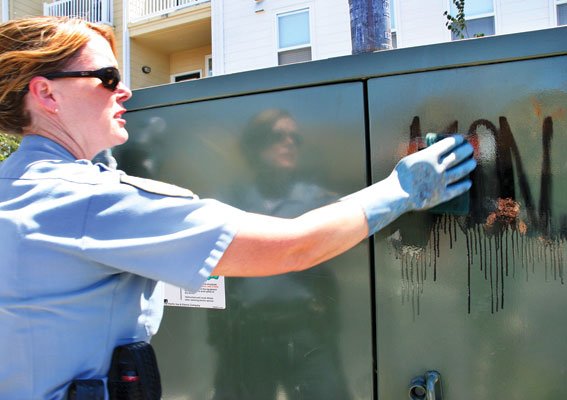Police arrested a 16-year-old whose graffiti spree left the
city, school district and business owners with a $10,000 bill.
Police arrested a 16-year-old whose graffiti spree left the city, school district and business owners with a $10,000 bill.
Police have linked the juvenile to more than 250 separate acts of graffiti, with at least 10 of the acts classified as felonies, resulting in more than $400 in damage each. The juvenile’s vandalism has claimed about 30 victims, police said. This is the juvenile’s fifth arrest.
“It’s disappointing,” said Gilroy Police Department Sgt. Chad Gallacinao. “You would hope that they would learn. It’s disappointing when they turn up again. And it’s not just disappointing for me, but also for members of community who keep being victims of the same people.”
After receiving citations for his first three arrests, the teen was nabbed for the fourth time in August after causing $8,000 in damage. Sentenced to house arrest, he continued to offend. His latest spree ended with his fifth arrest Wednesday, this time for an additional $2,000 in damage stemming from 15 incidents. He is being held in custody at the Santa Clara County Juvenile Hall.
The vandalism is not gang-related but the teen is part of a tagging crew, police said.
Although the juvenile justice system focuses on rehabilitating juveniles, “there’s a point when they have to be held accountable,” Gallacinao said.
“If it happens once or twice, you learn from experience and move on to do better,” he said. “When it’s three, four and five times, is he capable of being rehabilitated? That’s for the courts and the probation department to decide. We’re just going to keep investigating on our side.”
Although Gallacinao could not delve into the specifics of the juvenile’s case, he said the teen’s offenses will be consolidated into one case for review by the district attorney’s office, the police and the court. The teen could be sentenced to a range of options, including house arrest, confinement time at juvenile hall, restitution or probation.
“Obviously he didn’t learn the first, second or third time,” Gallacinao said.
So far, victims of the graffiti are footing the bill, he said.
“It’s frustrating because it’s a redirection of resources that need to go to the classroom,” said Enrique Palacios, deputy superintendent of business services for the school district.
Buying a can of paint to cover a school wall marred by graffiti uses up money that is supposed to be going toward day to day repairs, he said.
“When a pipe breaks or a toilet is backed up, that’s a health and safety problem,” he said. “I’ve got to fix that. Excessive graffiti eats into that budget and diverts money from the classroom.”
The school district devotes $100,000 worth of resources to clean up graffiti, annually, he said.
As part of the teen’s sentence, the court could order him and his family to pay for the damage.
Under house arrest, teens are permitted to attend school and work, said Delores Nnam, public information officer for the county probation department. She, too, would not release information specific to the juvenile but spoke in general about the correctional process. Typically, house arrestees are outfitted with an anklet that tracks their whereabouts and alerts the probation department when the teen violates his or her sentence. They are also paired with a counselor that drops by three to five times a week.
“Our goal is to try and treat the youth as much as possible,” Nnam said. “They’re not under 24-hour surveillance. The youth are entrusted to be at home. We ask parents to participate but recognize that they have to work.”













